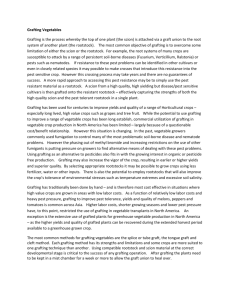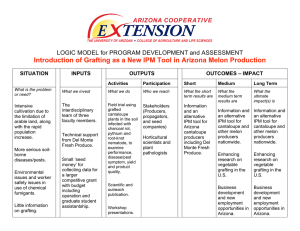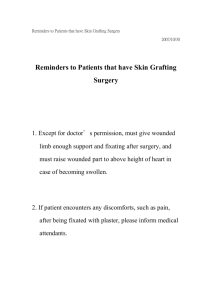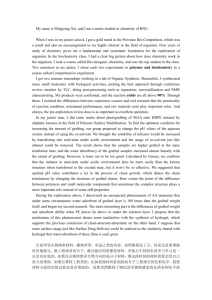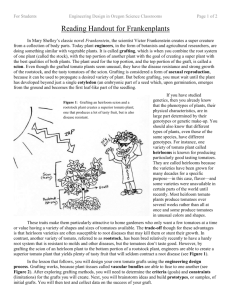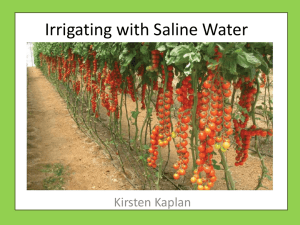Letter from the Chairman CONTENTS: Letter from the Chairman
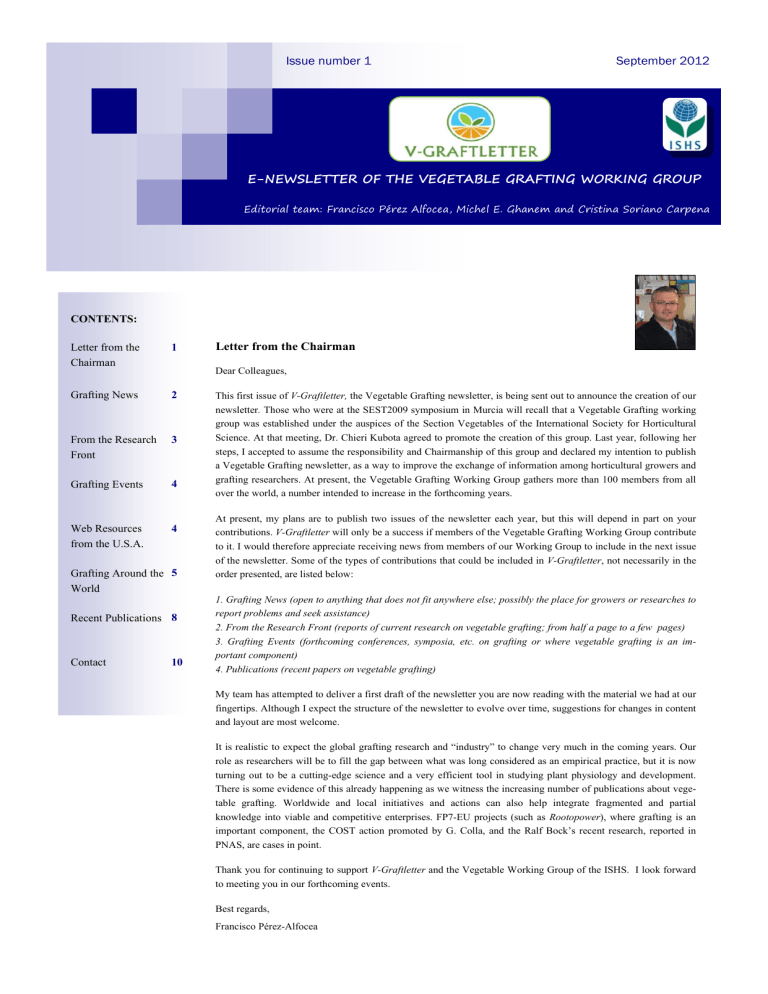
Issue number 1 September 2012
E-NEWSLETTER OF THE VEGETABLE GRAFTING WORKING GROUP
Editorial team: Francisco Pérez Alfocea, Michel E. Ghanem and Cristina Soriano Carpena
CONTENTS:
Letter from the
Chairman
Grafting News
1
2
From the Research
Front
3
Grafting Events 4
Web Resources from the U.S.A.
4
Grafting Around the
World
5
Recent Publications 8
Contact 10
Letter from the Chairman
Dear Colleagues,
This first issue of V-Graftletter, the Vegetable Grafting newsletter, is being sent out to announce the creation of our newsletter . Those who were at the SEST2009 symposium in Murcia will recall that a Vegetable Grafting working group was established under the auspices of the Section Vegetables of the International Society for Horticultural
Science. At that meeting, Dr. Chieri Kubota agreed to promote the creation of this group. Last year, following her steps, I accepted to assume the responsibility and Chairmanship of this group and declared my intention to publish a Vegetable Grafting newsletter, as a way to improve the exchange of information among horticultural growers and grafting researchers. At present, the Vegetable Grafting Working Group gathers more than 100 members from all over the world, a number intended to increase in the forthcoming years.
At present, my plans are to publish two issues of the newsletter each year, but this will depend in part on your contributions. V-Graftletter will only be a success if members of the Vegetable Grafting Working Group contribute to it. I would therefore appreciate receiving news from members of our Working Group to include in the next issue of the newsletter. Some of the types of contributions that could be included in V-Graftletter , not necessarily in the order presented, are listed below:
1. Grafting News (open to anything that does not fit anywhere else; possibly the place for growers or researches to report problems and seek assistance)
2. From the Research Front (reports of current research on vegetable grafting; from half a page to a few pages)
3. Grafting Events (forthcoming conferences, symposia, etc. on grafting or where vegetable grafting is an important component)
4. Publications (recent papers on vegetable grafting)
My team has attempted to deliver a first draft of the newsletter you are now reading with the material we had at our fingertips. Although I expect the structure of the newsletter to evolve over time, suggestions for changes in content and layout are most welcome.
It is realistic to expect the global grafting research and “industry” to change very much in the coming years. Our role as researchers will be to fill the gap between what was long considered as an empirical practice, but it is now turning out to be a cutting-edge science and a very efficient tool in studying plant physiology and development.
There is some evidence of this already happening as we witness the increasing number of publications about vegetable grafting. Worldwide and local initiatives and actions can also help integrate fragmented and partial knowledge into viable and competitive enterprises. FP7-EU projects (such as Rootopower ), where grafting is an important component, the COST action promoted by G. Colla, and the Ralf Bock’s recent research, reported in
PNAS, are cases in point.
Thank you for continuing to support V-Graftletter and the Vegetable Working Group of the ISHS. I look forward to meeting you in our forthcoming events.
Best regards,
Francisco Pérez-Alfocea
Issue number 1 ISHS
GRAFTING NEWS
A EU’S SEVENTH FRAMEWORK PROGRAMME PROJECT:
ROOTOPOWER
ROOTOPOWER, a KBBE (Knowledge
Based Bio-Economy) project funded under the 7 th Framework Programme of the European Union (#289365), is innovating in the field of root-science research in Europe. Its consortium, made up of 13 partners from countries such as Spain, United Kingdom,
Germany or Turkey, gathers top research
The ROOTOPOWER Consortium scientists from a wide array of root-related fields.
ROOTOPOWER aims to develop new tools, targeted to roots, to enhance agronomic stability and sustainability of dicotyledonous crops under multiple and combined stress conditions.
Central to its approach is the use of tomato as a model species, since its genome sequence is already available and it can be very easily grafted. This surgical technique attaches histologically shoot and root systems that are genetically different, allowing precise assessment of the effect of altering root genotype on crop performance of the grafted variety. This project will analyze and exploit the natural genetic variability existing in a recombinant inbred line population (RIL) from a cross between Solanum lycopersicum and S. pimpinellifolium and other selected mutants and functional lines
(used as rootstocks) for their performance under multiple abiotic stresses and for their biotic interaction with natural soil microorganisms (mycorrhiza and rhizobacteria).
ROOTOPOWER will obtain genetic information and physiological understanding of mechanisms vital for high-performing root systems.
ROOTOPOWER seeks to improve crop stress resistance and develop more resourceefficient crops, thus helping producers and breeders deal with the predicted impacts of climate change and to overcome the consequences of unsustainable agricultural practices that are causing soil degradation and depleting natural resources.
The kick-off meeting of ROOTOPOWER took place in Murcia (Spain) between the 6 th and 7 th February 2012. This first meeting was the starting point of this project with a foreseen duration of 4 years and an initial budget of circa 3,000,000M € . The meeting gathered Consortium partners, the EC project officer assigned to ROOTOPOWER and
CSIC representatives.
Further information at: http://rootopower. eu
COST ACTION ON VEGETABLE GRAFTING APPROVED
The COST ACTION (European Cooperation in Science and Technology) FA1204 - Vegetable Grafting to Improve Yield and Fruit
Quality Under Biotic and Abiotic Stress Conditions - has been recently approved in June
2012.
COST ACTIONs are networks centered around nationally and internationally funded research projects in fields that are of interest to at least five COST countries. The financial support averages EUR 130,000 per year for a four-year period.
This Action aims to stimulate cutting-edge multidisciplinary collaborative research towards identifying and understanding how rootstock-mediated traits can improve vegetable crop yield and quality under biotic and abiotic adverse conditions.
Sharing knowledge and enhancing scientific and technical collaboration will surely fill knowledge gaps in the area of vegetable grafting. This Action will also stimulate the wider commercial development and exploitation of this technique in Europe. The knowledge gained will be summarized in a book as a final output of this Action. Moreover, all data and information of this Action will be disseminated to the public through a dedicate website.
Those interested in joining the COST Action, please contact Dr. Colla ( contact details below )
Further information at : http://www.cost.eu/domains_actions/fa/Actions/FA1204
Action Chair: Giuseppe Colla ( giucolla@unitus.it)
Page 2
Issue number 1 ISHS
A natural graft between a birch (left) and an oak
(right). Sexually incompatible species can exchange chloroplast genomes at graft sites. (Image courtesy of Max
Planck Institute of Molecular
Plant Physiology)
FROM THE RESEARCH FRONT
GENETIC INFORMATION MIGRATES FROM
PLANT TO PLANT THROUGH GRAFTING
Recently, the group of Ralph Bock from the Max Planck Institute of
Molecular Plant Physiology in
Potsdam discovered that a transfer of entire chloroplasts, or at least their genomes, can occur in contact zones between plants. Inter-species crossing is not necessary. The new chloroplast genome can even be handed down to the next generation and, thereby, give a plant with new traits. These findings are of great importance to the understanding of evolution as well as the breeding of new plant varieties, and above all to grafting itself.
Plants, especially vegetables and wooden trees, are often grafted for many reasons. But graft junctions do not always have to be humanmade. Plants that simply grow in close vicinity to each other can also fuse.
In those contact zones between scion and rootstock, so called horizontal gene transfers (HGT), the transfer of genes without sexual reproduction, can occur. For a long time, scientists believed that HGT was restricted to prokaryotes
(bacteria for example). Nowadays it is increasingly appreciated that
HGT is in fact not restricted to prokaryotes. In 2009, Ralph Bock and Sandra Stegemann discovered that genetic information stored in the green chloroplasts can be transferred to another plant by means of horizontal gene transfer. Their results were, at that time, restricted to the transfer of genes between plants of the same species. show that complete chloroplast genomes can travel across the graft junction from one species into another. Even more interesting, the complete chloroplast genomes were even inherited by the next generation according to the authors.
The discovery of this process offers a new explanation for important evolutionary processes and opens up new possibilities for plant breeders and explains some phenomena and advantages observed in grafted vegetables and trees.
Journal Reference:
In this study, the authors have considered horizontal genome transfer across natural grafts as a mechanism underlying chloroplast capture in plants. By grafting sexually incompatible species, they
S. Stegemann, M. Keuthe, S.
Greiner, R. Bock. Horizontal transfer of chloroplast genomes between plant species. Proceedings of the
National Academy of Sciences ,
2012; DOI: 10.1073/ pnas.1114076109 “Elimination of the cotyledon axillary meristems eliminated the regrowth of the rootstock.”
Bausher, 2012
IMPORTANCE OF GRAFTING TECHNIQUE IN
ELIMINATING UNDESIRED SUCKERING
Vegetative grafting has been proposed as a technique for managing diseases in tomatoes under open-field conditions. Over 2 successive years, Micheal Bausher’s team investigated the use of grafting under open-field fresh tomato production and found a serious limitation with current grafting techniques, which resulted in recurring rootstock shoot regrowth
(‘‘suckering’’) from the rootstock cotyledons when left intact. Left unchecked, the regrowth of tomato rootstocks can envelop the experimental scions, which can impact the growth of field-grown tomatoes.
In the first year, four commercial cultivars were grafted by a commercial propagator.
These grafted plants were planted in a field experiment and after a time period, the number of rootstock suckers was counted and removed. This process was repeated over five time periods. The second year, Micheal
Bausher’s team grafted all of the plants below the rootstock cotyledons.
During five different time periods bud regrowth from the rootstock occurred in all studied rootstocks in the first year. The difference in the 2 years was dramatic. In the first year, the number of plants with rootstock regrowth was relatively high depending on the scion. In the second year, with a different grafting technique, no regrowth from the rootstocks was observed.
This study highlights the importance of the grafting technique on grafting success.
Reference:
Grafting Technique to Eliminate Rootstock
Suckering of Grafted Tomatoes
Michael G. Bausher
USDA-ARS U.S. Horticultural Research
Laboratory, 2001 South Rock Road,
Fort Pierce, FL 34982
Source: HortScience 46(4):596–598, 2011
Page 3
Issue number 1 ISHS
GRAFTING EVENTS
RELEVANT EVENTS WHERE ISHS DIRECTLY INTERVENES:
The SEST2012, the 6 th International Symposium on Seed, Transplant and Stand Establishment of Horticultural Crops, organised by the ISHS, took place in Brasilia (Brasil), 01-05 July 2012 . The next symposium, with central attention on grafting, will be provisionally held in South Africa, 2015 (information not yet confirmed).
Further information of SEST2012: http://www.sest2012.com/english/sest2012-home.html
1 st ISHS International Symposium on Grafting. After the success of the International Symposium on Vegetable Grafting that was held in Viterbo in October 2011, it was agreed that the First ISHS International Symposium on Grafting will take place in March 17-20, 2014 , in Wuhan (China). The convener of this meeting is Dr. Zhilong Bie, Director of the
Department of Vegetable Science in the Huazhong Agricultural University (China).
Further information at: http://www.ishs.org/news/?p=2008 , http://www.grafting2014.com (web site under construction)
The One-Day Vegetable Grafting Symposium organised by the USDA funded grafting consortium team (led by Frank
Louws) will be held in Maitland , Florida (United States), 8 November 2012 .
Further information at: http://mbao.org/ or contact Olha Sydorovych at obsydoro@ncsu.edu
RELATED EVENTS:
The 3 rd International Conference on Soil Bio- and Eco-Engineering entitled “The Use of Vegetation to Improve Slope
Stability” will be held in Vancouver (Canada), 23-27 July 2012 .
Further information at: http://inbe.cirad.fr
7 th Plant BioMechanics International Conference will take place in Clermont-Ferrand (France), 20-24 August 2012 .
Further information at: https://colloque.inra.fr/pbm2012
The International Symposium on Root Systems Biology will be held in Taipei (Taiwan), 19-21 September 2012 .
Further information at: http://isrsb.sinica.edu.tw/index.html
The Root Biology Meeting will be held in the University of Missouri, Missouri (US), 29-31 May 2013 . The Interdisciplinary Plant Group at Missouri is responsible for its organisation. More details to follow.
The ISRR 2012, the eighth Symposium of the International Society of Root Research entitled “Roots to the Future”, was held in Dundee (Scotland), 26-29 June 2012 . The next ISRR meeting will be held in Canberra (Australia), 2015 .
Further information at: http://www.rootresearch.org/meetings/isrr2012
“Horticultural products include all products, raw or processed, that arise from the horticultural industry”
WEB RESOURCES FROM THE U.S.A.
University of Arizona. This University has developed as part of their multi-year research and extension project on vegetable grafting conducted by their researchers an excellent website that contains many resources in the field of grafting. http://cals.arizona.edu/grafting/home
North Carolina State University http://www4.ncsu.edu/~clrivard/Resources.html
http://www4.ncsu.edu/~clrivard/TubeGraftingTechnique.pdf
Ohio State University-Vegetable Production System Laboratory http://hcs.osu.edu/vpslab/grafting http://hcs.osu.edu/vpslab/grafted-plants
Ohio State University Tomato Grafting Project http://oardc.osu.edu/graftingtomato/graft.htm
Washington State University Vegetable Research and Extension http://agsyst.wsu.edu/graftingVegetables.html
University of Vermont Extension http://www.uvm.edu/vtvegandberry
Page 4
Issue number 1 ISHS
AROUND THE GRAFTING WORLD
UNITED STATES OF AMERICA
SCHOOL OF PLANT SCIENCES, UNIVERSITY OF ARIZONA
1)
2)
3)
Dr. Chieri Kubota and her laboratory members in the School of Plant Sciences, University of Arizona, USA (http://cals.arizona.edu/research/ kubota) work on various propagation technologies as part of a coordinated project on vegetable grafting funded by USDA Specialty Crop Research
Initiative (Leading PI: Dr. Frank Louws, North Carolina State University). Research topics in the lab include:
Developing a short term storage technique of grafted vegetable seedlings and,
Evaluating use of unrooted grafted cuttings for better logistics to supply transplants to distant producers,
Developing a decision support system to analyze costs as well as logistics in grafting propagation in collaboration with Dr. Young-Jun Son
(Department of Industrial and Systems Engineering) and Dr. Russel Tronstad (Department of Agricultural and Resource Economics),
4) Working on LED technology for improving morphology of vegetable seedlings including grafting rootstocks.
Outreach programs of Dr. Kubota’s lab includes the Vegetable Grafting Information Website (http://cals.arizona.edu/grafting) which provides various tutorials and information on grafting. Dr. Kubota’s lab also published a DVD suitable for classroom use ‘Vegetable Grafting: Learning
How to Graft Tomato and Cucurbits' available for purchase from University of Arizona CALS Publications.
Dr. Chieri Kubota (left) and her current laboratory members
Recent publications:
Hernández, R. and C. Kubota. 2012. Tomato seedling growth and morphological responses to supplemental LED lighting red:blue ratios under varied daily solar light integrals. Acta Horticulturae (in press).
Yang, Z.-C.*, C. Kubota*, P.-L. Chia, and M. Kacira. 2012. Effect of end-of-day far-red light from a movable LED fixture on squash rootstock hypocotyl elongation. Scientia Horticulturae 136:81-86. [*equally contributing to the work]
Chia, P.-L. and C. Kubota. 2010. End-of-day far-red light quality and dose requirements for tomato rootstock hypocotyl elongation. HortScience 45:1501-1506.
Justus, I. and C. Kubota. 2010. Effects of low temperature storage on growth and transplant quality of non-grafted and grafted cantaloupe-type muskmelon seedlings. Scientia Hort. 125:47-54.
Contact person: Dr. Chieri Kubota. ckubota@ag.arizona.edu | http://cals.arizona.edu/research/kubota/Site/Kubota_Lab_Home.html
Page 5
Issue number 1 ISHS
AROUND THE GRAFTING WORLD
GREECE
LABORATORY OF VEGETABLE CROPS, DEPARTMENT OF CROP SCIENCE,
AGRICULTURAL UNIVERSITY OF ATHENS
The Laboratory of Vegetable Crops of the Agricultural University of Athens (LVC-AUA) was established in 1981. The LVC of AUA includes four members of academic staff (H.C. Passam, D. Savvas, C. Akoumianakis, I. Karapanos) and employs several associate researchers, most of which are affiliated either as M.Sc. or as Ph.D students. Grafting constitutes an important part among other research activities of the LVC of
AUA. In particular, the LVC of AUA focuses mainly on the following research topics related to grafting of fruit vegetables:
1) Efficiency of root genotypes to:
- restrict heavy metal uptake when exposed to heavy metal stress,
- enhance nutrient uptake and
- improve the tolerance of grafted plants to salinity.
2) Impact of grafting on quality characteristics of fruit vegetables
3) Use of suitable rootstocks that can improve the tolerance of greenhouse fruit vegetables to low or high temperature stress, which is a common problem in Mediterranean greenhouses.
Some of the above topics need to be approached from different physiological and genetic perspectives. Therefore, the LVC of AUA has established or is interested in establishing collaboration with other research institutes and laboratories with similar research interests at national and international level.
Cucumber cv. Creta grafted onto the rootstock ‘Power’ ( C. maxima × C. moschata ).
Overview of an experiment with grafted cucumber
Tomato cv. Belladona grafted onto the rootstock ‘He-Man’ ( S. lycopersicum × S. habrochaites ).
Recent publications :
Passam, H.C., Stylianou, M. and Kotsiras, A., 2005. Performance of eggplant grafted on tomato and eggplant rootstocks. Europ. J. Hort. Sci., 70, 130-134.
Savvas, D., Papastavrou, D., Ntatsi, G., Ropokis, A., Olympios, C., Hartman, H., Schwarz, D., 2009. Interactive effects of grafting and Mn-supply on growth, yield and nutrient uptake by tomato. HortScience 44, 1978-1982.
Savvas, D., Colla, G., Rouphael, Y., Schwarz, D., 2010. Amelioration of nutrient and heavy metal stress in fruit vegetables by grafting. Sci.Hort. 127, 156-161.
Savvas, D., Savva, A., Ntatsi, G., Ropokis, A., Karapanos, I., Krumbein, A., Olympios, C., 2011. Effects of three commercial rootstocks on mineral nutrition, fruit yield and quality in salinised tomatoes. J. Plant Nutr. Soil Sci. 174, 154–162.
Savvas, D., Ntatsi, G., Barouchas, P., 2012. Impact of Cd and Ni on cation uptake by cucumber grafted onto four commercial rootstocks Sci. Hort. (in press).
Ntatsi, G., Savvas, D., Schwarz, D., 2011. Role of abscisic acid in the adaptation of grafted tomato to moderately suboptimal temperature stress. ISHS Symposium “GREENSYS2011”, Chalkidiki, Greece, 6 - 10 June 2011. Acta Hort. (in press).
Savvas, D., Ntatsi, G., Moiras, N., Tsakalidis, A., Ropokis, A., Liopa-Tsakalidi, A., 2011. Impact of grafting and rootstock on the responses of cucumber to heavy metal stress. 5th Balkan Symp. Veget. & Potatoes. Tirana, 9-12 Oct. 2011. Acta Hort (in press).
Petropoulos S., Olympios C., Ntatsi G., Passam C. Effects of grafting and salinity on agronomic characteristics and ion uptake by cucumber plants grown in a closed hydroponic system. ISHS Symposium “GREENSYS2011”, Chalkidiki, Greece, 6 - 10 June 2011. Acta Hort. (in press).
Contact person: Dr. Dimitrios Savvas. dsavvas@aua.gr | http://efp.aua.gr/en
Page 6
Issue number 1 ISHS
AROUND THE GRAFTING WORLD
SPAIN
COMAV GRAFTING GROUP, CENTRO DE CONSERVACIÓN Y MEJORA DE LA
AGRODIVERSIDAD VALENCIANA, UNIVERSIDAD POLITÉCNICA DE VALENCIA
Our goal is the development of rootstocks for vegetable crops grafting. We work mainly with Solanaceae and Cucurbitaceae. Several related lines of research are underway at present:
1) Evaluation of resistance to Meloidogyne incognita , Phytopthora capsici and Monosporascus cannonballus ,
2) Root system characterization,
3) Development of rootstocks and their evaluation of compatibility, agronomic performance and fruit quality,
4) Genotyping for parental selection of hybrid rootstocks, and
5) Application of biotechnology for rootstock improvement.
Several members of different COMAV groups as well as researchers from other institutions related to plant breeding take part in these research lines.
Inoculation of pepper plantlets with zoospores of Phytophthora capsici
Evaluation of Cucumis melo roots infected with Monosporascus cannonballus and analyzed with the software WhinRhizo, specific for root image analysis
Evaluation of eggplant grafted plants in a field naturally infested with Meloidogyne incognita
Recent publications:
Gisbert C, Prohens J, Nuez F. 2011. Performance of eggplant grafted onto cultivated and wild materials and hybrids of eggplant and tomato. International Journal of Plant Production 5: 367-380
Gisbert C, Prohens J, Raigón MD, Stommel J, Nuez F. 2011. Eggplant relatives as sources of variation for developing new rootstocks: effects of grafting on yield and fruit apparent quality and composition. Scientia Horticulturae 128: 14-22
Gisbert C, Picó B, Nuez F. 2011. Regeneration in selected Cucurbita spp. germplasm. Cucurbit Genetics Cooperative . 34: 53-54
Gisbert C, Mulet JM, Prohens J, Picó B, Serrano R, Nuez F. 2011. Biotechnology for abiotic tolerance and nutritional improvement in selected genotypes of Solanum melongena AND Cucurbita moschata (ABSTRACT).
Current Opinion in Biotechnology 22 S : S15-S152. P44.
Contact person: Dr. Carmina Gisbert. cgisbert@btc.upv.es | http://www.comav.upv.es
Page 7
Issue number 1 ISHS
RECENT PUBLICATIONS
Title: The mRNA of a Knotted1-like transcription factor of potato is phloem mobile
Author(s): Mahajan, Ameya; Bhogale, Sneha; Kang, Il Ho; et al.
Source: PLANT MOLECULAR BIOLOGY Volume: 79 Issue: 6 Pages: 595-608 DOI: 10.1007/s11103-012-9931-
0 Published: AUG 2012
Title: Root-to-shoot Translocation of Alkaloids is Dominantly Suppressed in Nicotiana alata
Author(s): Pakdeechanuan, Phattharaporn; Shoji, Tsubasa; Hashimoto, Takashi
Source: PLANT AND CELL PHYSIOLOGY Volume: 53 Issue: 7 Pages: 1247-1254 DOI: 10.1093/pcp/ pcs065 Published: JUL 2012
Title: Gene Silencing in Arabidopsis Spreads from the Root to the Shoot, through a Gating Barrier, by Template-Dependent,
Nonvascular, Cell-to-Cell Movement
Author(s): Liang, Dacheng; White, Rosemary G.; Waterhouse, Peter M.
Source: PLANT PHYSIOLOGY Volume: 159 Issue: 3 Pages: 984-1000 DOI: 10.1104/pp.112.197129 Published: JUL
2012
Title: Grafting Tomato to Manage Bacterial Wilt Caused by Ralstonia solanacearum in the Southeastern United States
Author(s): Rivard, C. L.; O'Connell, S.; Peet, M. M.; et al.
Source: PLANT DISEASE Volume: 96 Issue: 7 Pages: 973-978 DOI: 10.1094/PDIS-12-10-0877 Published: JUL
2012
Title: Graft-union development: a delicate process that involves cell-cell communication between scion and stock for local auxin accumulation
Author(s): Yin, Hao; Yan, Bo; Sun, Jing; et al.
Source: JOURNAL OF EXPERIMENTAL BOTANY Volume: 63 Issue: 11 Pages: 4219-4232 DOI: 10.1093/jxb/ ers109 Published: JUN 2012
Title: Optimization of Substrate Formulation and Mineral Nutrition during the Production of Vegetable Seedling Grafts
Author(s): Choi, Jong Myung; Lee, Chiwon W.; Chun, Jong-Pil
Source: HORTICULTURE ENVIRONMENT AND BIOTECHNOLOGY Volume: 53 Issue: 3 Pages: 212-221 DOI:
10.1007/s13580-012-0108-1 Published: JUN 2012
Title: Improving melon and cucumber photosynthetic activity, mineral composition, and growth performance under salinity stress by grafting onto Cucurbita hybrid rootstocks
Author(s): Rouphael, Y.; Cardarelli, M.; Rea, E.; et al.
Source: PHOTOSYNTHETICA Volume: 50 Issue: 2 Pages: 180-188 DOI: 10.1007/s11099-012-0002-1 Published:
JUN 2012
Title: Grafting for Root-knot Nematode Control and Yield Improvement in Organic Heirloom Tomato Production
Author(s): Barrett, Charles E.; Zhao, Xin; McSorley, Robert
Source: HORTSCIENCE Volume: 47 Issue: 5 Pages: 614-620 Published: MAY 2012
Title: Evaluation of Grafting Using Hybrid Rootstocks for Management of Bacterial Wilt in Field Tomato Production
Author(s): McAvoy, Theodore; Freeman, Joshua H.; Rideout, Steven L.; et al.
Source: HORTSCIENCE Volume: 47 Issue: 5 Pages: 621-625 Published: MAY 2012
Title: Potato CONSTANS is involved in photoperiodic tuberization in a graft-transmissible manner
Author(s): Gonzalez-Schain, Nahuel D.; Diaz-Mendoza, Mercedes; Zurczak, Marek; et al.
Source: PLANT JOURNAL Volume: 70 Issue: 4 Pages: 678-690 DOI: 10.1111/j.1365-313X.2012.04909.x Published:
MAY 2012
Title: Growth and union acclimation process of sweet pepper grafted by a tubing-grafting robotic system
Author(s): Chang, Yung-Chiung; Chen, Suming; Chiu, Yi-Chich; et al.
Source: HORTICULTURE ENVIRONMENT AND BIOTECHNOLOGY Volume: 53 Issue: 2 Pages: 93-101 DOI:
10.1007/s13580-012-0085-4 Published: APR 2012
Page 8
Issue number 1 ISHS
Title: Cost Benefit Analysis of Using Grafted Transplants for Root-knot Nematode Management in Organic Heirloom Tomato Production
Author(s): Barrett, Charles E.; Zhao, Xin; Hodges, Alan W.
Source: HORTTECHNOLOGY Volume: 22 Issue: 2 Pages: 252-257 Published: APR 2012
Title: Rootstock control of scion transpiration and its acclimation to water deficit are controlled by different genes
Author(s): Marguerit, Elisa; Brendel, Oliver; Lebon, Eric; et al.
Source: NEW PHYTOLOGIST Volume: 194 Issue: 2 Pages: 416-429 DOI: 10.1111/j.1469-
8137.2012.04059.x Published: APR 2012
Title: Grafting method to improve vine production of orange fleshed sweet potato cultivar 'Resisto' under water stressed conditions
Author(s): Mihiretu, H. C.; Du Toit, E.; Steyn, J. M.; et al.
Source: SOUTH AFRICAN JOURNAL OF BOTANY Volume: 79 Pages: 234-234 Published: MAR 2012
Title: Grafting onto Cucurbita moschata rootstock alleviates salt stress in cucumber plants by delaying photoinhibition
Author(s): Liu, Z. X.; Bie, Z. L.; Huang, Y.; et al.
Source: PHOTOSYNTHETICA Volume: 50 Issue: 1 Pages: 152-160 DOI: 10.1007/s11099-012-0007-9 Published:
MAR 2012
Title: Effect of end-of-day far-red light from a movable LED fixture on squash rootstock hypocotyl elongation
Author(s): Yang, Zhen-Chao; Kubota, Chieri; Chia, Po-Lung; et al.
Source: SCIENTIA HORTICULTURAE Volume: 136 Pages: 81-86 DOI: 10.1016/j.scienta.2011.12.023 Published:
MAR 1 2012
Title: Grafting cucumber plants enhance tolerance to sodium chloride and sulfate salinization
Author(s): Colla, Giuseppe; Rouphael, Youssef; Rea, Elvira; et al.
Source: SCIENTIA HORTICULTURAE Volume: 135 Pages: 177-185 DOI: 10.1016/j.scienta.2011.11.023 Published:
FEB 24 2012
Title: Horizontal transfer of chloroplast genomes between plant species
Author(s): Stegemann, Sandra; Keuthe, Mandy; Greiner, Stephan; et al.
Source: PROCEEDINGS OF THE NATIONAL ACADEMY OF SCIENCES OF THE UNITED STATES OF AMERI-
CA Volume: 109 Issue: 7 Pages: 2434-2438 DOI: 10.1073/pnas.1114076109 Published: FEB 14 2012
Title: Cell-to-cell movement of plastids in plants
Author(s): Thyssen, Gregory; Svab, Zora; Maliga, Pal
Source: PROCEEDINGS OF THE NATIONAL ACADEMY OF SCIENCES OF THE UNITED STATES OF AMERI-
CA Volume: 109 Issue: 7 Pages: 2439-2443 DOI: 10.1073/pnas.1114297109 Published: FEB 14 2012
Title: Producing a Grafted and a Non-Grafted Tomato Plant from the Same Seedling
Author(s): Hanna, Hanna Y.
Source: HORTTECHNOLOGY Volume: 22 Issue: 1 Pages: 72-76 Published: FEB 2012
Title: Effect of grafting on growth and incidence of phytophthora blight and bacterial wilt of pepper (Capsicum annuum L.)
Author(s): Jang, Yoonah; Yang, Eunyoung; Cho, Myeongcheoul; et al.
Source: HORTICULTURE ENVIRONMENT AND BIOTECHNOLOGY Volume: 53 Issue: 1 Pages: 9-19 DOI:
10.1007/s13580-012-0074-7 Published: FEB 2012
Title: Defense Mechanisms Involved in Disease Resistance of Grafted Vegetables
Author(s): Guan, Wenjing; Zhao, Xin; Hassell, Richard; et al.
Source: HORTSCIENCE Volume: 47 Issue: 2 Pages: 164-170 Published: FEB 2012
Title: Accumulation of Weathered p,p '-DDTs in Grafted Watermelon
Author(s): Isleyen, Mehmet; Sevim, Pinar; White, Jason C.
Source: JOURNAL OF AGRICULTURAL AND FOOD CHEMISTRY Volume: 60 Issue: 4 Pages: 1113-1121 DOI:
10.1021/jf204150s Published: FEB 1 2012
Page 9
Issue Number 1 ISHS
International Society for Horticultural Science
The International Society for Horticultural Science - in short ISHS – dating from 1864 and formally constituted in 1959, has more than 7,000 members representing some 150 countries.
It is the world's leading independent organization of horticultural scientists and thus, a major source of up-to-date information on global horticultural research. ISHS aims to promote research in all branches of horticulture.
It encourages the development of international co-operation, bringing together scientificand technical professionals to stimulate, facilitate and coordinate research and scientific activities on a global scale.
ISHS publishes Acta Horticulturae,
Chronica Horticulturae, and Scripta
Horticulturae.
http://www.ishs.org/
We invite you to join our Working Group as a way of promoting research on grafting and encouraging contacts among scientists around the world.
Experience sharing and knowledge transfer can just be achieved with your participation!
Please visit:
http://www.ishs.org/science/V15.php
Dr. Francisco Pérez-Alfocea
Chair of the ISHS Vegetable Grafting Working Group
International Society for Horticultural Science (ISHS)
E DITORIAL TEAM CONTACT :
Cristina Soriano Carpena
Executive Assistant
Telephone: +34 968 396 241
Fax: +34 968 396 213
E-mail address: csoriano@cebas.csic.es
Page 10
